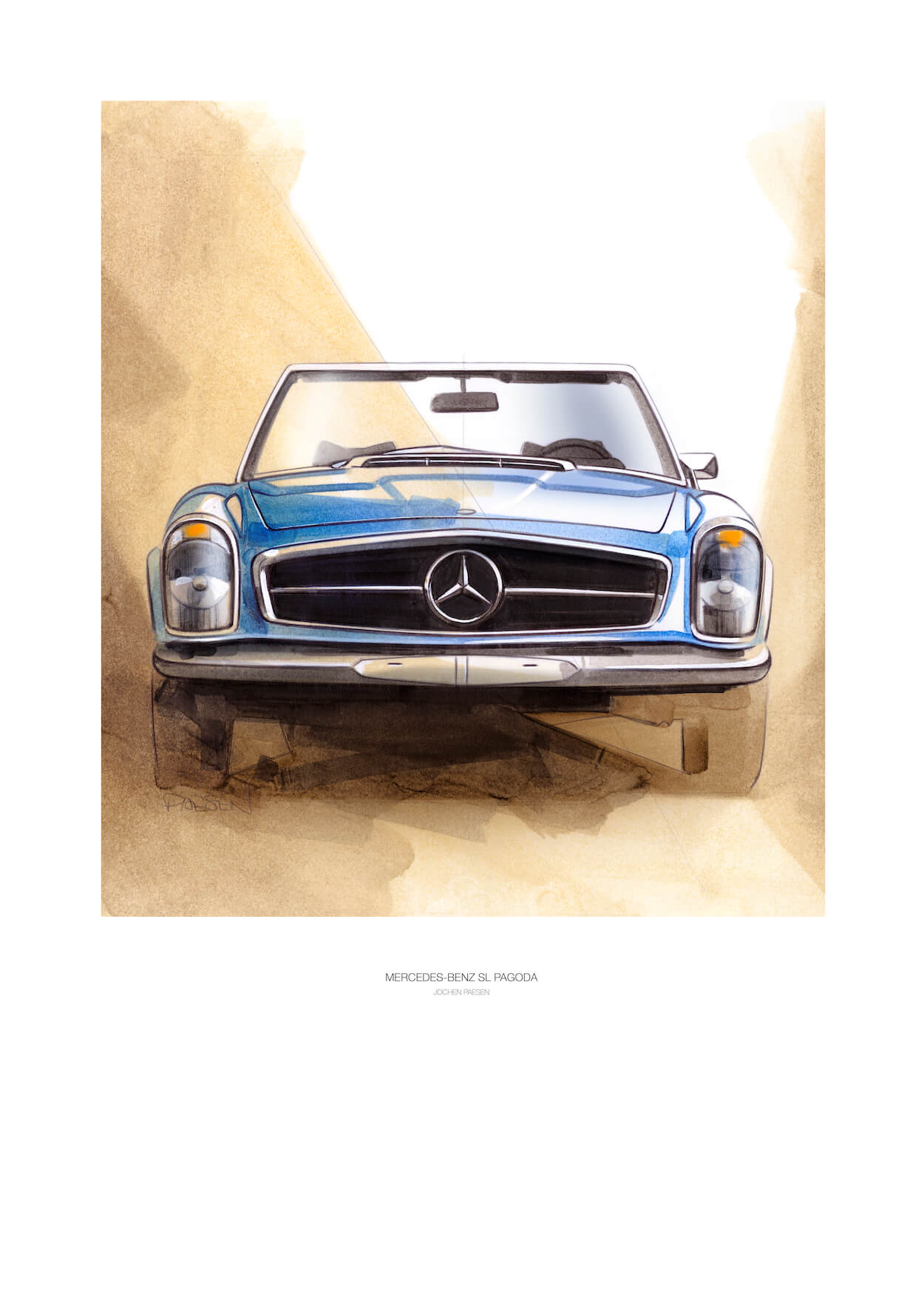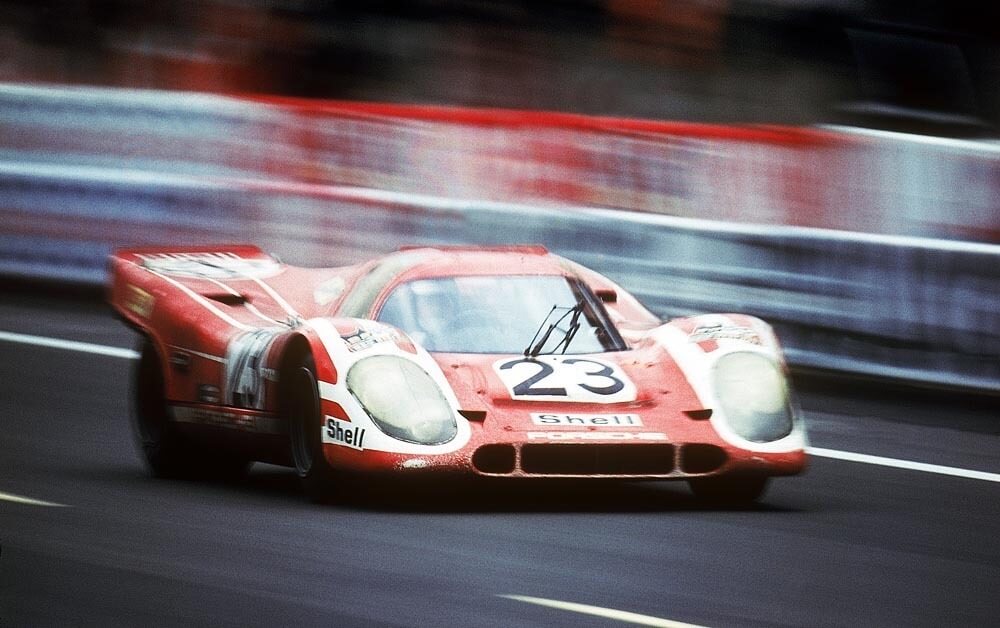Let's dive into the thrilling world of the Porsche 917, a masterfully engineered car designed to conquer the prestigious 24 Hours of Le Mans race, showcasing Germany's endurance racing supremacy. The Porsche team's journey began with the 356 race car, but they soon set their sights on creating cars to compete for the sought-after World Manufacturer's Title.
The Birth of the 917
In 1969, when the FIA announced a new class of "homologated sports cars" for the upcoming season, Porsche sprang into action and began work on their ambitious project—the 917. The new regulations dictated a minimum weight of 800 kg and a maximum engine capacity of 5 liters. The 917 featured a powerful 4.5-liter, 12-cylinder engine, a significant upgrade from the previous season's 3-liter V8 engine in the 908.

1969 April 22. F. Piech on the left, Helmut Bott on the right. FIA officials Herbert Schmity and Dean Delamont in the middle.
Chief engineer Hans Mezger, under the guidance of Ferdinand Piech, crafted this beast of an engine by combining two 2.25 flat-6 engines from earlier racing cars. The result was astounding—the "Type 912" engine delivered a roaring 520 horsepower.

Two Cars, One Goal
The Porsche racing engineers had an ingenious plan—they developed two body designs for the 917, optimizing performance for both short, twisty tracks and long straights. The 917K (Kurzheck), with a shorter tail, proved to be a track demon, while the 917 LH (Langheck) was tailor-made for the grueling Le Mans race. These cars soon proved their mettle, reaching unbeatable speeds, with Jackie Oliver hitting a jaw-dropping 396 km/h during night testing before the 1971 Grand Prix.
1969: A Year of Practice
The racing debut of the 917 happened at the 1000 km of Spa. Jo Siffert, the leading Porsche driver at the time, went out on the track by declaring to the engineering team that his car "is not only unstable, but it is frankly dangerous“.
The Porsche 917 didn't behave neither in quick curves, nor in straight lines. It was a false start for the new racing program, as “Seppi” Siffert later chose to compete in the 908 Long Tail from last year. The team faced teething issues, and only two 917 cars entered the race, failing to cross the finish line despite setting the fastest qualification times.
1969 continued as a year of testing. The aluminum frame with a weight of under 50 kg struggled with the massive engines, which was capable of catapulting the 917 to 200 km/h in just over 5 seconds.


Porsche 917 LH-60 Homologation Spec
Challenging the Status Quo at Le Mans
917s were the fastest cars at the Le Mans track in 1969. The fastest lap during the race went to Vic Elford and Richard Attwood, but unfortunately they had to retire from the leading position because of clutch failure. The only private 917 in the race this year was driven by the Englishman John Woolfe. Tragically he crashed in the opening lap, got thrown out of the car and lost his life.

Porsche 917 at Spa 1000 km. 1969
1970: A Triple Podium
For the following season, Porsche agreed to collaborate with John Wyer Engineering. The American JW team became the factory team. It was a tremendous season for Porsche – the brand not only dominated the tracks around the world but also became a successful business case. The original production series of twenty-five 917s cannot satisfy the demand. Over 50 chassis were built in total.
All cars from the previous year received larger 4.9- and 5.0-litre engines as the smaller capacity engine turned out to be unreliable at longer distances. For that year the plastic cover above the engine was removed and new aerodynamic changes were made to generate downforce instead of the unintended lift. Two Long-tails were set to start in Le Mans.


The Moment of Truth
Almost half of the cars at the starting grid were 917s. Wyer was surprised to discover that another team had been carefully preparing for the 1970 24 Hours of Le Mans with a close support from Porsche. The Porsche Salzburg went out to race under the direct guidance of the Porsche family. The Martini Racing team also gained support from Porsche AG. It looked like Porsche really wanted to win this time.
Two 917 LHs entered the 1970 race. One with the 4.9-litre and one with the 4.5-litre engine. The 4.9-litre LH started from pole position. Unfortunately, event the newer, larger engine didn’t endure the 24 hours and dropped an inlet valve after 225 laps.
Despite the heavy rain, Porsche 917 won the race in 1970 with the drivers Hans Herrmann and Richard Attwood from the Porsche Salzburg team. Their short-tailed 917K #23 in red and white stripes obtained the first victory for the marque in the most critical race of the Championship.
The other Martini Racing 917 LH finished second with Gérard Larrousse/Willy Kauhsen behind the wheel. Because of the car’s livery, it was nicknamed the hippie-Porsche or the psychedelic-Porsche. Interestingly, this isn’t the only psychedelic 917. A short-tail version 917K is also made for the Watkins Glen 6 Hours. The livery is designed by the Latvian Anatole ‘Tony’ Lapine, who is the head designer at Porsche. He will later design the livery of the 71’ Pink Pig as well.

Porsche Salzburg Le Mans-winning Hermann/Attwood car. Shot included to show the changes made to the body of the car work very late in 1969; different door line, no exhaust exits aft of the doors, wedge shape and Lola inspired rear deck.
A Movie Star
Porsche not only won Le Mans that year but also helped Steve McQueen film a legendary motorsports picture. The movie Le Mans was filmed between June and November 1970 on location at the Le Mans circuit. It includes scenes from the actual race in mid-June as well. McQueen intended to race a short Porsche 917 together with Jackie Stewart, but the entry of the #26 does not get accepted. Instead, his character starts the race in the blue #20 Gulf Porsche 917K driven by Jo Siffert and Brian Redman.
1971: Unbeatable
New competitоrs arrived for the new season. Along with the Alfa Romeo T33/3 which won Brands Hatch, Roger Penske is one of many privateers who had bought an used 512S chassis from Ferrari. He had some ideas for modifications on his mind and later the blue and yellow Sunoco-sponsored Ferrari was tuned for long races. It received a new aerodynamic wing at the back and an engine overhaul by a Can-Am V8 specialist Traco. The 512S was capable of more than 600 hp. Sadly for Penske, the team didn’t receive any help from Ferrari. Although they had good pace and high speeds at 24 Hours of Daytona and 12 Hours of Sebring, they just wasn’t good enough to be a serious contender for the 917 racing armada.
Meanwhile the 917 was further improved for the season with vertical fins for stability at high-speed cornering. The new frame was also refined. The chassis was made from magnesium and was even lighter, yet extraordinarily flammable and dangerous in the instance of fire.
Once again it’s not a LH that wins at Le Mans. It is the white-blue Martini Racing 917 K with Gijs van Lennemp and Dr Helmut Marko. Their win also set a new average speed record of 222 km/h and a total distance of 5,335 km. This record still stands today, but it is important to note that a few changes have been made to the circuit since 1971.
The Pink Pig
The so-called Pink Pig was a racing concept car specially developed for Le Mans. The Porsche 917/20, also known as the Trufflehunter of Zuffenhausen (“Der Trüffeljäger von Zuffenhausen”) had new aerodynamics and parts to be tested for the Can-Am series. The body of the car was much wider with a tail somewhere in between the K and LH versions. They wanted to achieve the smaller drag and the top speed of the original Long-tail (“Langheck”) . Surprisingly the 917/20 made it through the qualifying with the seventh-best time but didn't sew the finish flag.

The idea to paint it like a pig came from the Porsche design manager Anatole “Tony” Lapine.
The Porsche 917's legacy was cemented, transforming Porsche from an underdog to a leader in sports car racing. Its triumphs on the track and on the silver screen made it an icon of speed and performance.

1971 Le Mans winner Martini Porsche 917 driven by Helmut Marko and Gijs van Lennep


